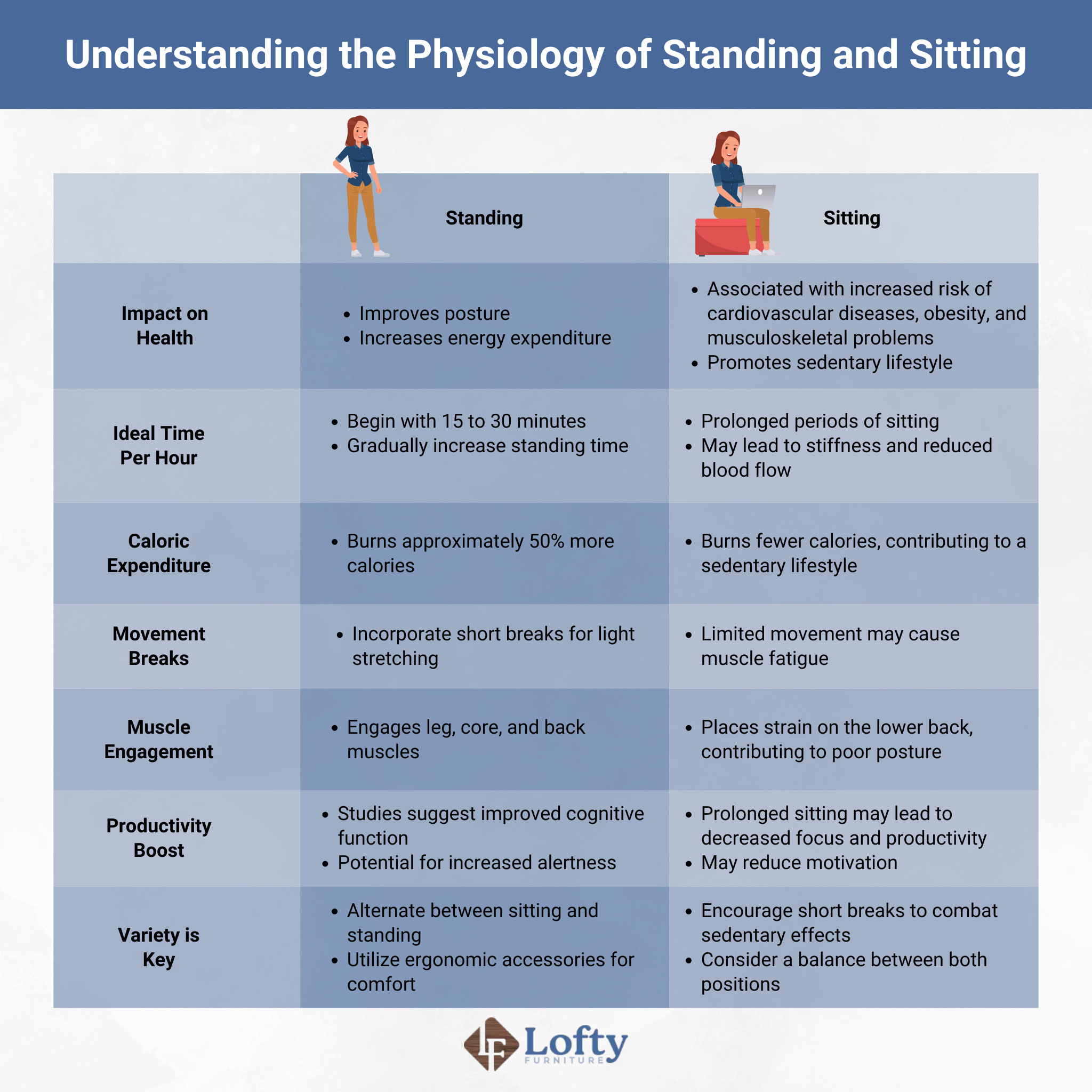In an era dominated by sedentary lifestyles and prolonged hours spent at desks, standing desks have gained traction owing to the potential benefits they offer. However, as with any lifestyle change, the question arises: How long should one stand at a standing desk to maximize the positive effects without compromising overall well-being?
The optimal duration for standing at a standing desk is about 15 to 30 minutes per hour, gradually increasing as your body adjusts. Striking a balance between sitting and standing is key to reaping the health benefits without causing fatigue or discomfort.
In this article, we will explore the optimal duration for standing at your desk. We’ll dive into the fascinating physiology behind it all and uncover the growing popularity of these desks due to their numerous health benefits.
Understanding the Physiology of Standing and Sitting

If you are wondering how long you should stand at a standing desk, it is important to consider the impact of prolonged sitting on your overall health. Research shows that sitting for extended periods of time can increase the risk of chronic conditions such as obesity, diabetes, and cardiovascular disease.
On the other hand, standing has been found to have beneficial effects on circulation and energy levels, improving blood flow and reducing fatigue. However, it is also crucial to consider musculoskeletal considerations and find a balance between standing and sitting to prevent discomfort or strain on your body.
The Impact of Prolonged Sitting on Overall Health
Sitting for long periods of time can have detrimental effects on our overall health. Studies show that prolonged sitting increases the risk of obesity, heart disease, diabetes, and even premature death. It also leads to poor posture and muscle imbalances.
However, incorporating regular movement into your day can counteract these negative effects. Taking active breaks throughout the day is crucial to maintaining good health. Simple strategies, such as standing up every hour or taking short walks, can make a big difference.
Additionally, incorporating a kneeling chair into your workspace, alongside using a standing desk, instead of sitting all day can help reduce sitting time and promote better posture.
Musculoskeletal Considerations: Balancing Standing and Sitting

Achieving a musculoskeletal balance is crucial to preventing the health implications associated with prolonged sitting or standing.
While standing desks offer numerous advantages, it is essential to consider your standing posture and duration. Maintaining proper ergonomics while standing can help prevent discomfort and musculoskeletal issues. Remember to keep your feet flat on the ground, distribute your weight evenly, and avoid slouching or leaning forward.
Additionally, it is recommended to take regular sitting breaks throughout the day. Research suggests that alternating between sitting and standing every 30 minutes can reduce the risk of developing musculoskeletal disorders and improve overall well-being.
By incorporating these practices into your work routine, you can optimize productivity while safeguarding your physical health.
Growing Popularity and Health Benefits of Standing Desks

Standing desk research suggests that these innovative workstations can have a positive impact on your overall well-being. By promoting better posture, standing desks help reduce musculoskeletal issues commonly associated with prolonged sitting.
Office workstation ergonomics play a crucial role in optimizing productivity, and standing desks are no exception. They provide an opportunity for increased movement throughout the day, which can enhance blood flow and prevent fatigue.
One of the key benefits of using a standing desk is its ability to combat sedentary behavior. Studies have shown that excessive sitting time is linked to an increased risk of chronic diseases such as obesity, diabetes, and cardiovascular problems.
By incorporating periods of standing into your work routine, you actively counteract these risks while burning more calories compared to sitting.
If you find yourself experiencing fatigue after extended periods at a standing desk, there are alternatives to consider, especially for gamers or office workers. One option is using an adjustable sit-stand desk that allows you to switch between sitting and standing positions throughout the day. This flexibility provides an optimal balance between rest and activity.
Embracing the growing popularity of standing desks can offer numerous health benefits. From improved posture to increased calorie burn and reduced sedentary behavior, these innovative workstations contribute positively to your overall well-being.
To know if you should pick a standing desk or ergonomic chair, you might want to read our comparison to know which is better for you.
Factors Influencing Standing Desk Duration

To fully maximize the benefits of your elevated work setup, consider factors such as comfort, fatigue levels, and breaks throughout the day that can influence how long you remain upright. These factors are crucial in determining the optimal duration for standing at a standing desk.
Physiology plays a significant role in determining how long you should stand at your desk. Standing for extended periods of time can cause discomfort and fatigue, leading to decreased productivity. It is important to listen to your body and adjust accordingly.
Various guidelines suggest alternating between sitting and standing every 30 minutes to an hour. This helps prevent prolonged sedentary behavior while giving your body a chance to rest. Additionally, taking short breaks during the day allows you to stretch your muscles, increasing blood flow and reducing the risk of muscle strain or injury.
Practical tips for determining the appropriate duration include gradually increasing standing time over weeks or months instead of jumping into long hours immediately. Investing in an anti-fatigue mat can also provide added comfort and support.
Remember, finding the right balance is essential when it comes to using a standing desk. By considering these factors and following practical guidelines, you can optimize your work experience while reaping the health benefits of increased movement throughout your day.
Recommended Standing Time Guidelines

Determining the ideal duration and desk height when using an elevated workstation is crucial, and following recommended standing time guidelines can help optimize your work experience.
It is important to note that there is no one-size-fits-all answer to how long you should stand at a standing desk as it varies from person to person. However, experts suggest starting with short periods of standing and gradually increasing the duration over time.
The recommended standing time for beginners is about 15-30 minutes per hour, gradually working up to 1-2 hours per day. This allows your body to adjust and prevents excessive strain on your muscles and joints.
To make the transition easier, consider some practical tips. Start by wearing comfortable shoes that provide adequate support. Maintain proper ergonomics and posture by keeping your monitor at eye level, adjusting your keyboard height, and avoiding slouching or leaning forward.
Additionally, taking regular breaks throughout the day can further reduce the risk of discomfort or fatigue. Consider incorporating stretching exercises or short walks into your routine.
Following recommended standing time guidelines, along with practicing good ergonomics and posture, can help maximize the benefits of using a standing desk while minimizing potential risks. Remember to gradually transition into longer periods of standing and listen to your body’s cues for optimal comfort during work hours.
Practical Tips for Implementing a Standing Desk Routine

When it comes to implementing a standing desk routine, there are several practical tips that can help you make the transition smoothly.
Ergonomics and Proper Posture
Maintaining proper posture and ergonomics while using a standing desk is essential for preventing strain on your muscles and joints. To create an ergonomic workspace, start by adjusting the height of your desk so that your elbows are at a 90-degree angle when typing. Keep your shoulders relaxed, and avoid slouching or leaning forward.
Remember to distribute your weight evenly between both feet to reduce standing fatigue.
In addition to correct posture, incorporating active sitting can help alleviate discomfort from prolonged standing. Consider using a stool or balance board that allows for movement and engages your core muscles. Desk exercises, such as shoulder rolls, neck stretches, and calf raises, can also be beneficial in reducing muscle tension.
Gradual Transition: Easing into Standing Gradually
Making a sudden transition from sitting all day to standing for long periods of time can put strain on your body and increase your risk of discomfort or injury. Always give yourself time to adjust.
Start by setting small goals for yourself. Begin with shorter intervals of standing, gradually increasing the duration as your comfort level improves. Remember that it is not about standing all day but finding the right balance between sitting and standing.
By easing into this transition, you allow your body to adapt slowly and build up strength over time. This gradual adjustment will help minimize any potential discomfort while still reaping the benefits of using a standing desk.
Incorporating Standing Breaks Throughout the Day

Throughout your workday, make sure to incorporate regular breaks where you can stand up and stretch for a quick rejuvenation. Research has shown that incorporating standing breaks throughout the day can have numerous productivity benefits.
Not only does it reduce sedentary behavior, but it also improves blood circulation and helps prevent muscle stiffness. Standing for short periods of time can increase energy levels and improve focus, leading to increased productivity and creativity.
To make the most of these standing breaks, consider investing in a standing desk or adjustable workstation that allows you to easily switch between sitting and standing positions. There are various options available on the market, including height-adjustable desks and desk converters that can be placed on top of your existing workspace.
Finding the Right Standing Height for Optimal Comfort
To achieve optimal comfort while working, it is important to find the right height for your standing position.
Finding the right standing position starts with adjusting your desk height. Stand straight with your elbows at a 90-degree angle, and adjust the desk so that your forearms are parallel to the ground and avoid strain on your wrists.
Another factor to consider is proper footwear for standing. Choose shoes that provide adequate support and cushioning to reduce foot fatigue. Additionally, using a footrest can help improve blood circulation and alleviate pressure on your feet.
Lastly, don’t forget about the importance of stretching throughout the day. Take short breaks to stretch your legs, back, and neck muscles to maintain flexibility and minimize discomfort while standing at your desk.
Listening to Your Body
Listen to what your body’s telling you and respond accordingly. When using a standing desk, it is important to listen to your body’s physical sensations and practice body awareness. Pay attention to any discomfort or fatigue that may arise during prolonged standing. Your body will provide valuable feedback on how long you should stand at your desk.
It is crucial to prioritize self-care and mindful movement throughout the day. Take breaks when needed, alternating between sitting and standing positions. Experiment with different durations of standing time until you find what works best for you. Remember that everyone’s unique, so there is no set time that applies to everyone.
Standing Desk Tools and Accessories
When it comes to the ideal desk ergonomics, there are a few key accessories that can help improve your posture and reduce fatigue. Standing desk tools and accessories, known for their low electricity consumption, can enhance your work environment, making it more comfortable and efficient.
A height-adjustable monitor stand is essential for maintaining proper eye-level alignment, while an ergonomic keyboard and mouse can prevent strain on your wrists and arms.
Anti-fatigue mats provide cushioning for your feet, reducing discomfort during prolonged standing.
Additionally, a footrest can help alleviate pressure on your lower back and promote better circulation.
By investing in these standing desk accessories, you can create an ergonomic setup that promotes good posture and reduces the risk of fatigue or musculoskeletal issues. This will ultimately lead to increased productivity and overall well-being at work.
Standing Desk Mistakes To Avoid

While different kinds of standing desks have gained popularity for their potential benefits, it is important to understand the right way to use them.
- Do not neglect the importance of posture. Standing with proper alignment, keeping your shoulders relaxed and your back straight, can help prevent strain on your neck, shoulders, and lower back.
- Avoid an improper desk setup. Make sure your monitor is at eye level, allowing you to maintain a neutral neck position. Use an ergonomic keyboard and mouse to reduce strain on your wrists and arms. Consider investing in an anti-fatigue mat to provide cushioning support for your feet.
- Standing fatigue and varicose veins is another possible issue that people may face when using standing desks. It is crucial to listen to your body and take breaks when needed. Alternate between sitting and standing throughout the day, or try using a height-adjustable desk so you can switch positions easily.
- Don’t forget about productivity tips while working at a standing desk. Incorporate movement into your routine by stretching or taking short walks during breaks. Stay hydrated, and wear comfortable shoes that provide adequate support.
You might be interested in exploring kneeling chairs as ergonomic chair alternatives for your workspace.
The Standing Revolution: Paving the Path to a Healthier Workspace
In conclusion, finding the right balance between sitting and standing at your desk is crucial for optimal health. Remember to listen to your body’s cues and gradually increase your standing time.
Incorporate breaks and movement throughout the day to avoid prolonged static positions. By following recommended guidelines and implementing practical tips, you can reap the numerous benefits of a standing desk while avoiding common mistakes.
If you’re interested, you might want to read about the benefits of sitting Indian style too.
